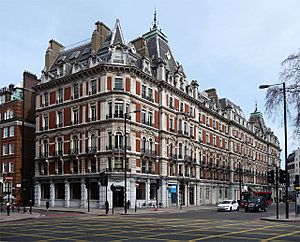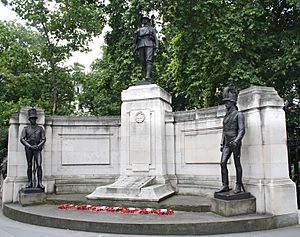Grosvenor Gardens facts for kids
Quick facts for kids
A3215 road |
||||
|---|---|---|---|---|
| Lua error in Module:Infobox_road/map at line 15: attempt to index field 'wikibase' (a nil value). | ||||

Grosvenor Gardens south
|
||||
| Route information | ||||
| Length | 0.1 mi (0.2 km) | |||
| Major junctions | ||||
| East end | A3214 Buckingham Palace Road | |||
|
||||
| East end | A302 Grosvenor Gardens | |||
| Location | ||||
| Primary destinations: |
Victoria | |||
| Road network | ||||
|
||||
Grosvenor Gardens is a special place in Belgravia, a fancy part of London, England. It's actually two triangular parks with streets on their sides that share the same name. These streets, also called Grosvenor Gardens, run from Hobart Place and Grosvenor Place down to Buckingham Palace Road. The entire road is known as the A3215. It's a short but important road, only about 0.1 miles long.
Contents
Buildings and Memorials
Grosvenor Gardens is home to some interesting buildings and monuments. They tell stories about the area's history and the people who lived there.
Grosvenor Gardens House
One important building is Grosvenor Gardens House at numbers 23–47. It was built around 1868 by an architect named Thomas Cundy III. The building has a special design called French Renaissance style. This means it looks like grand French castles from a long time ago. It is also a Grade II-listed building, which means it's officially protected because of its historical importance.
The Rifle Brigade Memorial
In Grosvenor Gardens, you'll find the Rifle Brigade War Memorial. This monument remembers the brave soldiers of the Rifle Brigade. It honors their service in both the First and Second World Wars. The memorial stands where Grosvenor Gardens meets Hobart Place. The land for the memorial was given by the 2nd Duke of Westminster, a very important person in the area.
Shell-Covered Huts
In the southern part of the garden, there are some unique huts covered in shells. These huts were part of a new design for the park in 1952. The design was created by Jean Moreux, a famous architect from France. These buildings are called fabrique style, which means they are decorative structures often found in gardens. They are covered with shells collected from both England and France. Today, these charming huts are used to store gardening tools and equipment.
Lioness and Lesser Kudu Sculpture
The northern garden features a cool sculpture called Lioness and Lesser Kudu. This artwork was created by the artist Jonathan Kenworthy. It was placed in the garden in the year 2000.
Famous People Who Lived Here
Many notable people have lived in Grosvenor Gardens over the years. Some of them have even been honored with special blue plaques on their homes. A blue plaque is a sign that tells you a famous person once lived or worked in that building.
- Henry Eliot, 5th Earl of St Germans (1835–1911): He was a nobleman who lived at No. 13.
- John Eliot, 6th Earl of St Germans (1890–1922): He was Henry's son and was born and lived at No. 13.
- Thomas Forbes (1900–1988): This poet grew up in the house at No. 15.
- Count Hayashi Tadasu (1850–1913): He was the very first Ambassador from Japan to Great Britain. He lived at No. 4.
- Agnes Keyser: During the First World War, Agnes Keyser opened a hospital at No. 9. This hospital was set up to care for British officers who were injured. It later became known as King Edward VII's Hospital for Officers.
- Augustus Pitt Rivers (1827–1900): He was an important archaeologist who lived at No. 4. His home is marked with a blue plaque.
- F. E. Smith, 1st Earl of Birkenhead (1872–1930): This well-known politician lived at No. 32. His former home also has a blue plaque.




